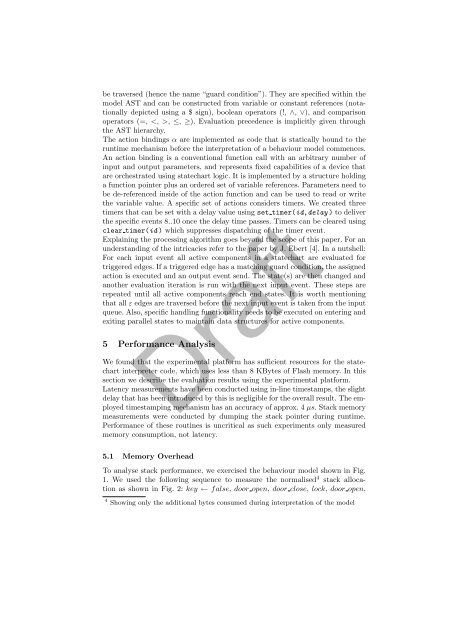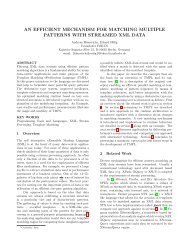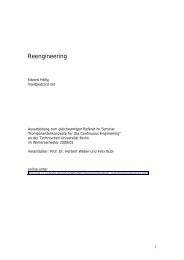Download a draft version of the paper
Download a draft version of the paper
Download a draft version of the paper
Create successful ePaper yourself
Turn your PDF publications into a flip-book with our unique Google optimized e-Paper software.
e traversed (hence <strong>the</strong> name “guard condition”). They are specified within <strong>the</strong>model AST and can be constructed from variable or constant references (notationallydepicted using a $ sign), boolean operators (!, ∧, ∨), and comparisonoperators (=, , ≤, ≥). Evaluation precedence is implicitly given through<strong>the</strong> AST hierarchy.The action bindings α are implemented as code that is statically bound to <strong>the</strong>runtime mechanism before <strong>the</strong> interpretation <strong>of</strong> a behaviour model commences.An action binding is a conventional function call with an arbitrary number <strong>of</strong>input and output parameters, and represents fixed capabilities <strong>of</strong> a device thatare orchestrated using statechart logic. It is implemented by a structure holdinga function pointer plus an ordered set <strong>of</strong> variable references. Parameters need tobe de-referenced inside <strong>of</strong> <strong>the</strong> action function and can be used to read or write<strong>the</strong> variable value. A specific set <strong>of</strong> actions considers timers. We created threetimers that can be set with a delay value using set timer(id,delay ) to deliver<strong>the</strong> specific events 8..10 once <strong>the</strong> delay time passes. Timers can be cleared usingclear timer(id ) which suppresses dispatching <strong>of</strong> <strong>the</strong> timer event.Explaining <strong>the</strong> processing algorithm goes beyond <strong>the</strong> scope <strong>of</strong> this <strong>paper</strong>. For anunderstanding <strong>of</strong> <strong>the</strong> intricacies refer to <strong>the</strong> <strong>paper</strong> by J. Ebert [4]. In a nutshell:For each input event all active components in a statechart are evaluated fortriggered edges. If a triggered edge has a matching guard condition, <strong>the</strong> assignedaction is executed and an output event send. The state(s) are <strong>the</strong>n changed andano<strong>the</strong>r evaluation iteration is run with <strong>the</strong> next input event. These steps arerepeated until all active components reach end states. It is worth mentioningthat all ε edges are traversed before <strong>the</strong> next input event is taken from <strong>the</strong> inputqueue. Also, specific handling functionality needs to be executed on entering andexiting parallel states to maintain data structures for active components.5 Performance AnalysisDraftWe found that <strong>the</strong> experimental platform has sufficient resources for <strong>the</strong> statechartinterpreter code, which uses less than 8 KBytes <strong>of</strong> Flash memory. In thissection we describe <strong>the</strong> evaluation results using <strong>the</strong> experimental platform.Latency measurements have been conducted using in-line timestamps, <strong>the</strong> slightdelay that has been introduced by this is negligible for <strong>the</strong> overall result. The employedtimestamping mechanism has an accuracy <strong>of</strong> approx. 4 µs. Stack memorymeasurements were conducted by dumping <strong>the</strong> stack pointer during runtime.Performance <strong>of</strong> <strong>the</strong>se routines is uncritical as such experiments only measuredmemory consumption, not latency.5.1 Memory OverheadTo analyse stack performance, we exercised <strong>the</strong> behaviour model shown in Fig.1. We used <strong>the</strong> following sequence to measure <strong>the</strong> normalised 4 stack allocationas shown in Fig. 2: key ← false, door open, door close, lock, door open,4 Showing only <strong>the</strong> additional bytes consumed during interpretation <strong>of</strong> <strong>the</strong> model





